MGMT20144 Essay: Impact of Digitalisation & Globalisation Post-Covid
VerifiedAdded on 2023/05/02
|7
|2872
|311
Essay
AI Summary
This essay examines the transformative impact of the COVID-19 pandemic on digitalisation and globalisation. It discusses how the pandemic accelerated the adoption of digital technologies by businesses, leading to increased e-commerce, remote operations, and digital globalisation. The essay highlights both the opportunities, such as cost savings and improved efficiency, and the challenges, including the digital divide, infrastructure limitations in developing countries, and the need for talent training. It also provides examples of companies like Amazon, Kmart, and Mecca that have successfully leveraged digital technologies to adapt to the changing business environment. The essay concludes that while digitalisation and globalisation offer significant potential, overcoming barriers and investing in digital infrastructure are crucial for businesses and economies to thrive in the post-COVID world. Desklib offers a range of solved assignments for students.
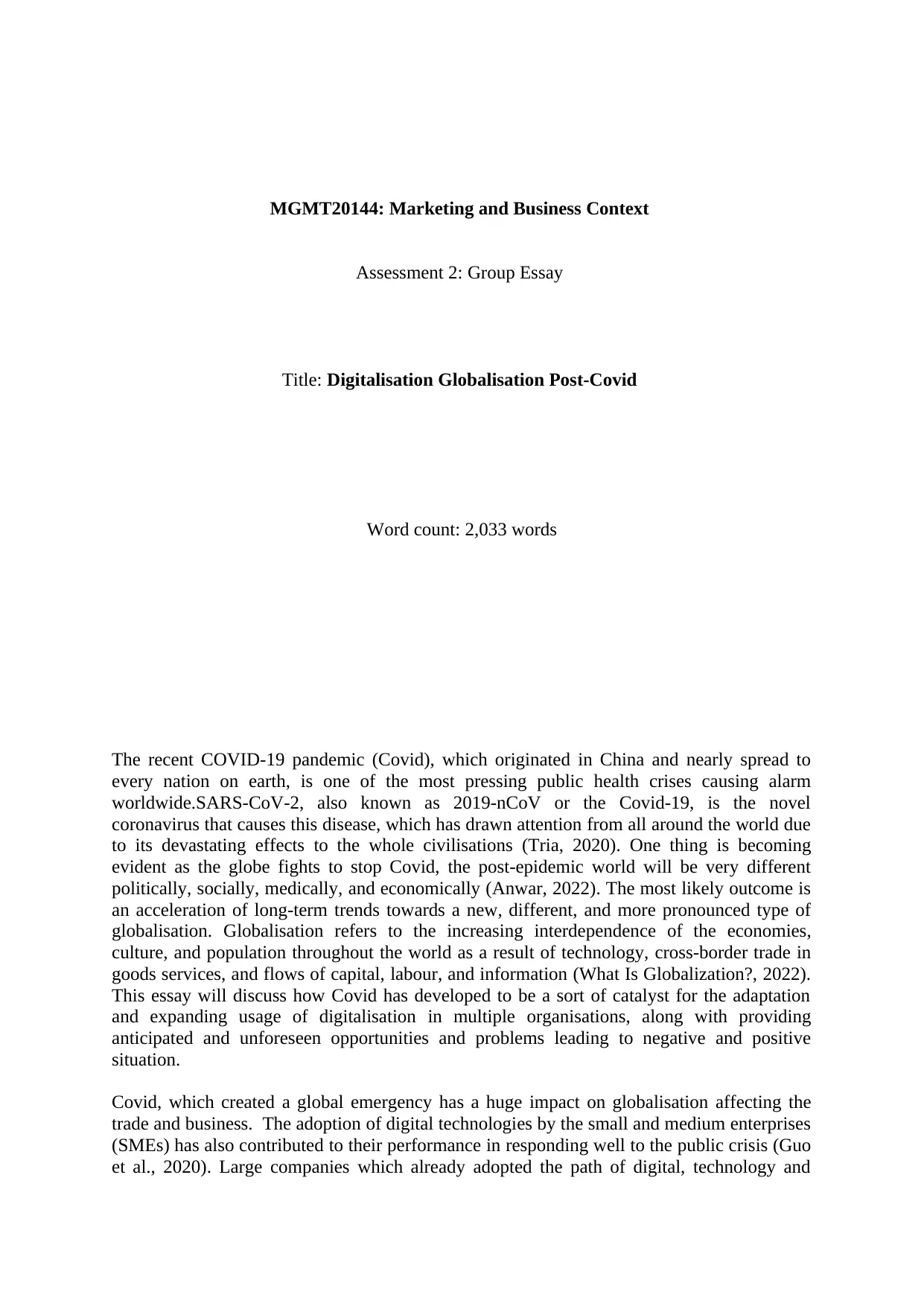
MGMT20144: Marketing and Business Context
Assessment 2: Group Essay
Title: Digitalisation Globalisation Post-Covid
Word count: 2,033 words
The recent COVID-19 pandemic (Covid), which originated in China and nearly spread to
every nation on earth, is one of the most pressing public health crises causing alarm
worldwide.SARS-CoV-2, also known as 2019-nCoV or the Covid-19, is the novel
coronavirus that causes this disease, which has drawn attention from all around the world due
to its devastating effects to the whole civilisations (Tria, 2020). One thing is becoming
evident as the globe fights to stop Covid, the post-epidemic world will be very different
politically, socially, medically, and economically (Anwar, 2022). The most likely outcome is
an acceleration of long-term trends towards a new, different, and more pronounced type of
globalisation. Globalisation refers to the increasing interdependence of the economies,
culture, and population throughout the world as a result of technology, cross-border trade in
goods services, and flows of capital, labour, and information (What Is Globalization?, 2022).
This essay will discuss how Covid has developed to be a sort of catalyst for the adaptation
and expanding usage of digitalisation in multiple organisations, along with providing
anticipated and unforeseen opportunities and problems leading to negative and positive
situation.
Covid, which created a global emergency has a huge impact on globalisation affecting the
trade and business. The adoption of digital technologies by the small and medium enterprises
(SMEs) has also contributed to their performance in responding well to the public crisis (Guo
et al., 2020). Large companies which already adopted the path of digital, technology and
Assessment 2: Group Essay
Title: Digitalisation Globalisation Post-Covid
Word count: 2,033 words
The recent COVID-19 pandemic (Covid), which originated in China and nearly spread to
every nation on earth, is one of the most pressing public health crises causing alarm
worldwide.SARS-CoV-2, also known as 2019-nCoV or the Covid-19, is the novel
coronavirus that causes this disease, which has drawn attention from all around the world due
to its devastating effects to the whole civilisations (Tria, 2020). One thing is becoming
evident as the globe fights to stop Covid, the post-epidemic world will be very different
politically, socially, medically, and economically (Anwar, 2022). The most likely outcome is
an acceleration of long-term trends towards a new, different, and more pronounced type of
globalisation. Globalisation refers to the increasing interdependence of the economies,
culture, and population throughout the world as a result of technology, cross-border trade in
goods services, and flows of capital, labour, and information (What Is Globalization?, 2022).
This essay will discuss how Covid has developed to be a sort of catalyst for the adaptation
and expanding usage of digitalisation in multiple organisations, along with providing
anticipated and unforeseen opportunities and problems leading to negative and positive
situation.
Covid, which created a global emergency has a huge impact on globalisation affecting the
trade and business. The adoption of digital technologies by the small and medium enterprises
(SMEs) has also contributed to their performance in responding well to the public crisis (Guo
et al., 2020). Large companies which already adopted the path of digital, technology and
Paraphrase This Document
Need a fresh take? Get an instant paraphrase of this document with our AI Paraphraser
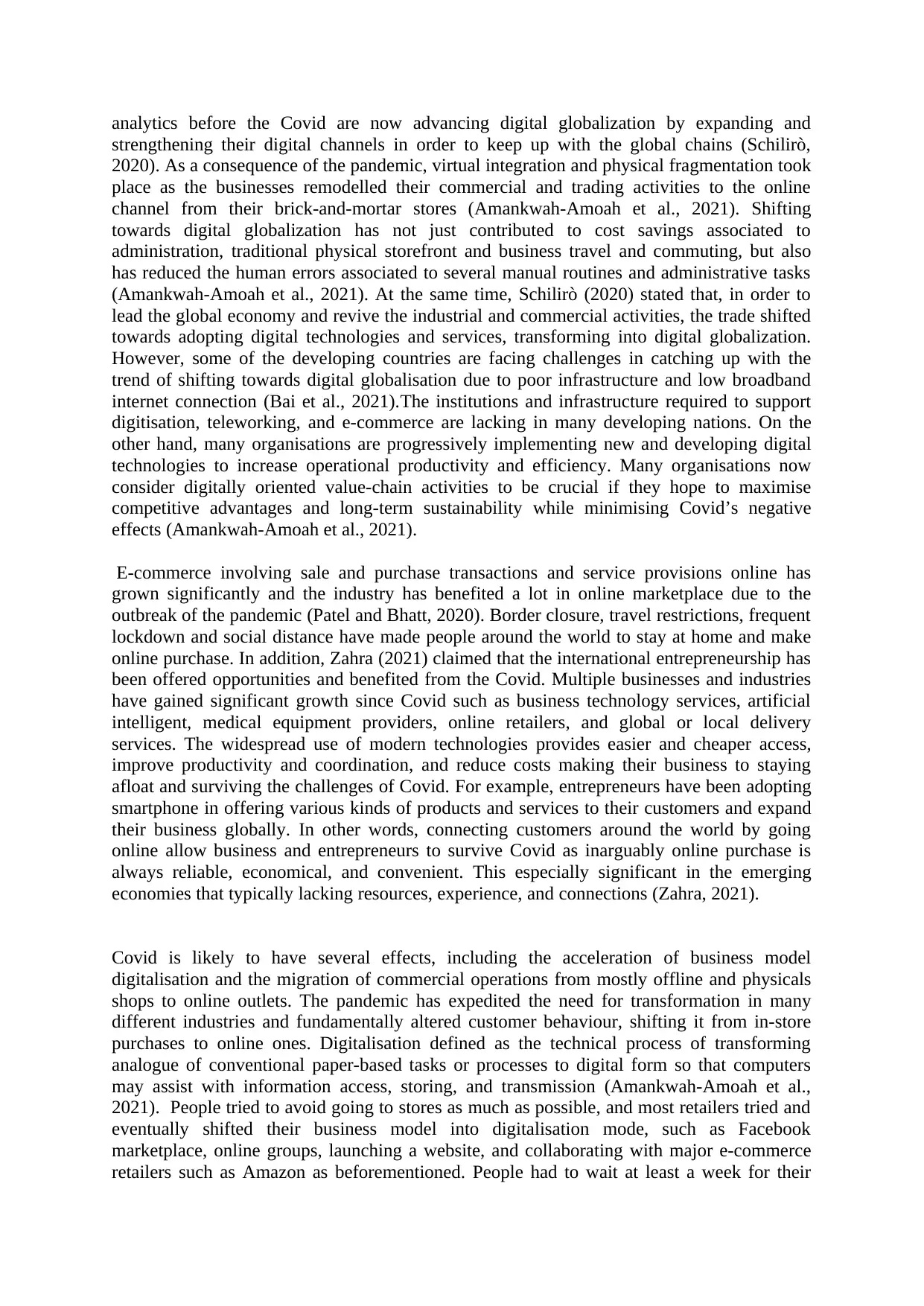
analytics before the Covid are now advancing digital globalization by expanding and
strengthening their digital channels in order to keep up with the global chains (Schilirò,
2020). As a consequence of the pandemic, virtual integration and physical fragmentation took
place as the businesses remodelled their commercial and trading activities to the online
channel from their brick-and-mortar stores (Amankwah-Amoah et al., 2021). Shifting
towards digital globalization has not just contributed to cost savings associated to
administration, traditional physical storefront and business travel and commuting, but also
has reduced the human errors associated to several manual routines and administrative tasks
(Amankwah-Amoah et al., 2021). At the same time, Schilirò (2020) stated that, in order to
lead the global economy and revive the industrial and commercial activities, the trade shifted
towards adopting digital technologies and services, transforming into digital globalization.
However, some of the developing countries are facing challenges in catching up with the
trend of shifting towards digital globalisation due to poor infrastructure and low broadband
internet connection (Bai et al., 2021).The institutions and infrastructure required to support
digitisation, teleworking, and e-commerce are lacking in many developing nations. On the
other hand, many organisations are progressively implementing new and developing digital
technologies to increase operational productivity and efficiency. Many organisations now
consider digitally oriented value-chain activities to be crucial if they hope to maximise
competitive advantages and long-term sustainability while minimising Covid’s negative
effects (Amankwah-Amoah et al., 2021).
E-commerce involving sale and purchase transactions and service provisions online has
grown significantly and the industry has benefited a lot in online marketplace due to the
outbreak of the pandemic (Patel and Bhatt, 2020). Border closure, travel restrictions, frequent
lockdown and social distance have made people around the world to stay at home and make
online purchase. In addition, Zahra (2021) claimed that the international entrepreneurship has
been offered opportunities and benefited from the Covid. Multiple businesses and industries
have gained significant growth since Covid such as business technology services, artificial
intelligent, medical equipment providers, online retailers, and global or local delivery
services. The widespread use of modern technologies provides easier and cheaper access,
improve productivity and coordination, and reduce costs making their business to staying
afloat and surviving the challenges of Covid. For example, entrepreneurs have been adopting
smartphone in offering various kinds of products and services to their customers and expand
their business globally. In other words, connecting customers around the world by going
online allow business and entrepreneurs to survive Covid as inarguably online purchase is
always reliable, economical, and convenient. This especially significant in the emerging
economies that typically lacking resources, experience, and connections (Zahra, 2021).
Covid is likely to have several effects, including the acceleration of business model
digitalisation and the migration of commercial operations from mostly offline and physicals
shops to online outlets. The pandemic has expedited the need for transformation in many
different industries and fundamentally altered customer behaviour, shifting it from in-store
purchases to online ones. Digitalisation defined as the technical process of transforming
analogue of conventional paper-based tasks or processes to digital form so that computers
may assist with information access, storing, and transmission (Amankwah-Amoah et al.,
2021). People tried to avoid going to stores as much as possible, and most retailers tried and
eventually shifted their business model into digitalisation mode, such as Facebook
marketplace, online groups, launching a website, and collaborating with major e-commerce
retailers such as Amazon as beforementioned. People had to wait at least a week for their
strengthening their digital channels in order to keep up with the global chains (Schilirò,
2020). As a consequence of the pandemic, virtual integration and physical fragmentation took
place as the businesses remodelled their commercial and trading activities to the online
channel from their brick-and-mortar stores (Amankwah-Amoah et al., 2021). Shifting
towards digital globalization has not just contributed to cost savings associated to
administration, traditional physical storefront and business travel and commuting, but also
has reduced the human errors associated to several manual routines and administrative tasks
(Amankwah-Amoah et al., 2021). At the same time, Schilirò (2020) stated that, in order to
lead the global economy and revive the industrial and commercial activities, the trade shifted
towards adopting digital technologies and services, transforming into digital globalization.
However, some of the developing countries are facing challenges in catching up with the
trend of shifting towards digital globalisation due to poor infrastructure and low broadband
internet connection (Bai et al., 2021).The institutions and infrastructure required to support
digitisation, teleworking, and e-commerce are lacking in many developing nations. On the
other hand, many organisations are progressively implementing new and developing digital
technologies to increase operational productivity and efficiency. Many organisations now
consider digitally oriented value-chain activities to be crucial if they hope to maximise
competitive advantages and long-term sustainability while minimising Covid’s negative
effects (Amankwah-Amoah et al., 2021).
E-commerce involving sale and purchase transactions and service provisions online has
grown significantly and the industry has benefited a lot in online marketplace due to the
outbreak of the pandemic (Patel and Bhatt, 2020). Border closure, travel restrictions, frequent
lockdown and social distance have made people around the world to stay at home and make
online purchase. In addition, Zahra (2021) claimed that the international entrepreneurship has
been offered opportunities and benefited from the Covid. Multiple businesses and industries
have gained significant growth since Covid such as business technology services, artificial
intelligent, medical equipment providers, online retailers, and global or local delivery
services. The widespread use of modern technologies provides easier and cheaper access,
improve productivity and coordination, and reduce costs making their business to staying
afloat and surviving the challenges of Covid. For example, entrepreneurs have been adopting
smartphone in offering various kinds of products and services to their customers and expand
their business globally. In other words, connecting customers around the world by going
online allow business and entrepreneurs to survive Covid as inarguably online purchase is
always reliable, economical, and convenient. This especially significant in the emerging
economies that typically lacking resources, experience, and connections (Zahra, 2021).
Covid is likely to have several effects, including the acceleration of business model
digitalisation and the migration of commercial operations from mostly offline and physicals
shops to online outlets. The pandemic has expedited the need for transformation in many
different industries and fundamentally altered customer behaviour, shifting it from in-store
purchases to online ones. Digitalisation defined as the technical process of transforming
analogue of conventional paper-based tasks or processes to digital form so that computers
may assist with information access, storing, and transmission (Amankwah-Amoah et al.,
2021). People tried to avoid going to stores as much as possible, and most retailers tried and
eventually shifted their business model into digitalisation mode, such as Facebook
marketplace, online groups, launching a website, and collaborating with major e-commerce
retailers such as Amazon as beforementioned. People had to wait at least a week for their
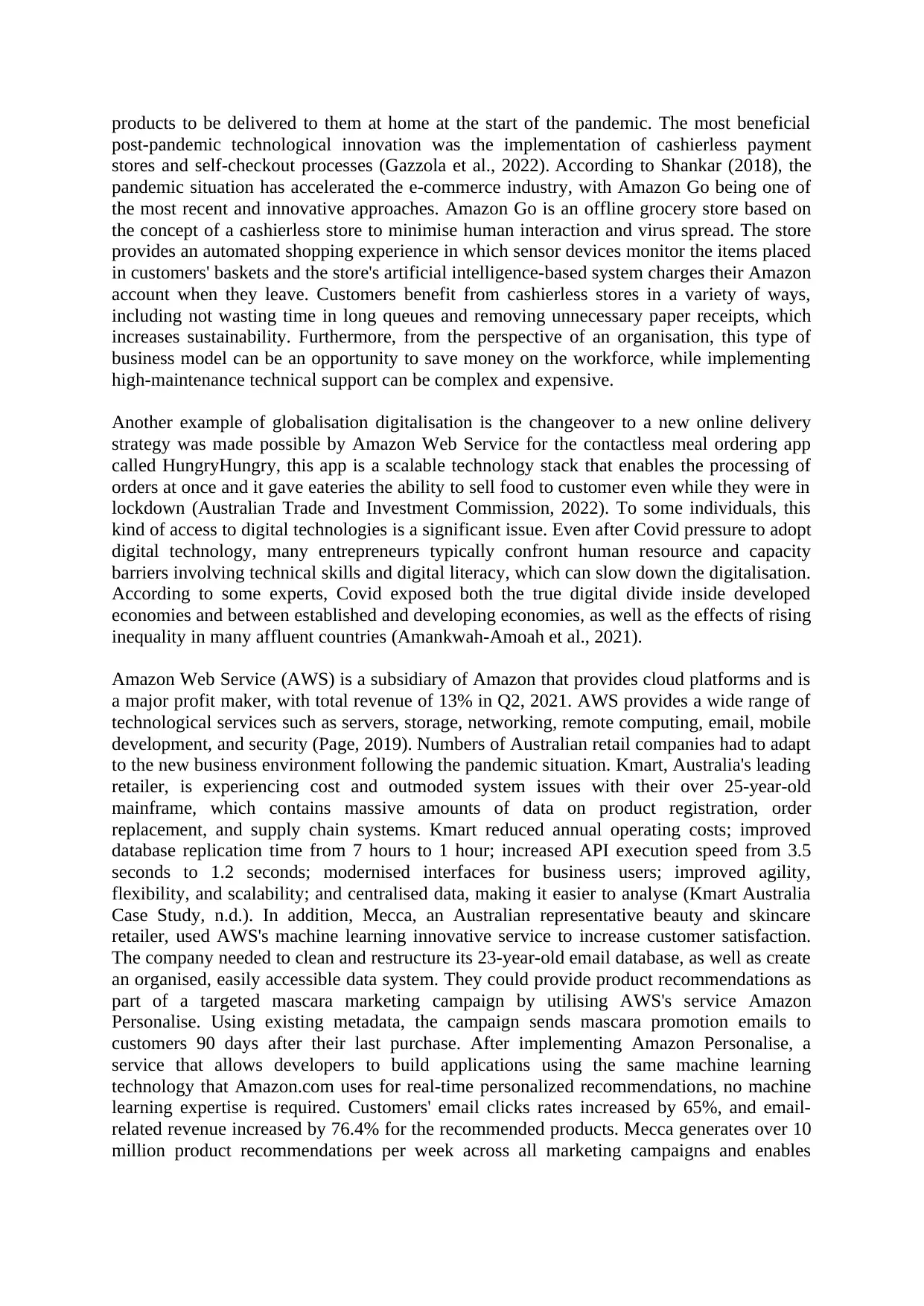
products to be delivered to them at home at the start of the pandemic. The most beneficial
post-pandemic technological innovation was the implementation of cashierless payment
stores and self-checkout processes (Gazzola et al., 2022). According to Shankar (2018), the
pandemic situation has accelerated the e-commerce industry, with Amazon Go being one of
the most recent and innovative approaches. Amazon Go is an offline grocery store based on
the concept of a cashierless store to minimise human interaction and virus spread. The store
provides an automated shopping experience in which sensor devices monitor the items placed
in customers' baskets and the store's artificial intelligence-based system charges their Amazon
account when they leave. Customers benefit from cashierless stores in a variety of ways,
including not wasting time in long queues and removing unnecessary paper receipts, which
increases sustainability. Furthermore, from the perspective of an organisation, this type of
business model can be an opportunity to save money on the workforce, while implementing
high-maintenance technical support can be complex and expensive.
Another example of globalisation digitalisation is the changeover to a new online delivery
strategy was made possible by Amazon Web Service for the contactless meal ordering app
called HungryHungry, this app is a scalable technology stack that enables the processing of
orders at once and it gave eateries the ability to sell food to customer even while they were in
lockdown (Australian Trade and Investment Commission, 2022). To some individuals, this
kind of access to digital technologies is a significant issue. Even after Covid pressure to adopt
digital technology, many entrepreneurs typically confront human resource and capacity
barriers involving technical skills and digital literacy, which can slow down the digitalisation.
According to some experts, Covid exposed both the true digital divide inside developed
economies and between established and developing economies, as well as the effects of rising
inequality in many affluent countries (Amankwah-Amoah et al., 2021).
Amazon Web Service (AWS) is a subsidiary of Amazon that provides cloud platforms and is
a major profit maker, with total revenue of 13% in Q2, 2021. AWS provides a wide range of
technological services such as servers, storage, networking, remote computing, email, mobile
development, and security (Page, 2019). Numbers of Australian retail companies had to adapt
to the new business environment following the pandemic situation. Kmart, Australia's leading
retailer, is experiencing cost and outmoded system issues with their over 25-year-old
mainframe, which contains massive amounts of data on product registration, order
replacement, and supply chain systems. Kmart reduced annual operating costs; improved
database replication time from 7 hours to 1 hour; increased API execution speed from 3.5
seconds to 1.2 seconds; modernised interfaces for business users; improved agility,
flexibility, and scalability; and centralised data, making it easier to analyse (Kmart Australia
Case Study, n.d.). In addition, Mecca, an Australian representative beauty and skincare
retailer, used AWS's machine learning innovative service to increase customer satisfaction.
The company needed to clean and restructure its 23-year-old email database, as well as create
an organised, easily accessible data system. They could provide product recommendations as
part of a targeted mascara marketing campaign by utilising AWS's service Amazon
Personalise. Using existing metadata, the campaign sends mascara promotion emails to
customers 90 days after their last purchase. After implementing Amazon Personalise, a
service that allows developers to build applications using the same machine learning
technology that Amazon.com uses for real-time personalized recommendations, no machine
learning expertise is required. Customers' email clicks rates increased by 65%, and email-
related revenue increased by 76.4% for the recommended products. Mecca generates over 10
million product recommendations per week across all marketing campaigns and enables
post-pandemic technological innovation was the implementation of cashierless payment
stores and self-checkout processes (Gazzola et al., 2022). According to Shankar (2018), the
pandemic situation has accelerated the e-commerce industry, with Amazon Go being one of
the most recent and innovative approaches. Amazon Go is an offline grocery store based on
the concept of a cashierless store to minimise human interaction and virus spread. The store
provides an automated shopping experience in which sensor devices monitor the items placed
in customers' baskets and the store's artificial intelligence-based system charges their Amazon
account when they leave. Customers benefit from cashierless stores in a variety of ways,
including not wasting time in long queues and removing unnecessary paper receipts, which
increases sustainability. Furthermore, from the perspective of an organisation, this type of
business model can be an opportunity to save money on the workforce, while implementing
high-maintenance technical support can be complex and expensive.
Another example of globalisation digitalisation is the changeover to a new online delivery
strategy was made possible by Amazon Web Service for the contactless meal ordering app
called HungryHungry, this app is a scalable technology stack that enables the processing of
orders at once and it gave eateries the ability to sell food to customer even while they were in
lockdown (Australian Trade and Investment Commission, 2022). To some individuals, this
kind of access to digital technologies is a significant issue. Even after Covid pressure to adopt
digital technology, many entrepreneurs typically confront human resource and capacity
barriers involving technical skills and digital literacy, which can slow down the digitalisation.
According to some experts, Covid exposed both the true digital divide inside developed
economies and between established and developing economies, as well as the effects of rising
inequality in many affluent countries (Amankwah-Amoah et al., 2021).
Amazon Web Service (AWS) is a subsidiary of Amazon that provides cloud platforms and is
a major profit maker, with total revenue of 13% in Q2, 2021. AWS provides a wide range of
technological services such as servers, storage, networking, remote computing, email, mobile
development, and security (Page, 2019). Numbers of Australian retail companies had to adapt
to the new business environment following the pandemic situation. Kmart, Australia's leading
retailer, is experiencing cost and outmoded system issues with their over 25-year-old
mainframe, which contains massive amounts of data on product registration, order
replacement, and supply chain systems. Kmart reduced annual operating costs; improved
database replication time from 7 hours to 1 hour; increased API execution speed from 3.5
seconds to 1.2 seconds; modernised interfaces for business users; improved agility,
flexibility, and scalability; and centralised data, making it easier to analyse (Kmart Australia
Case Study, n.d.). In addition, Mecca, an Australian representative beauty and skincare
retailer, used AWS's machine learning innovative service to increase customer satisfaction.
The company needed to clean and restructure its 23-year-old email database, as well as create
an organised, easily accessible data system. They could provide product recommendations as
part of a targeted mascara marketing campaign by utilising AWS's service Amazon
Personalise. Using existing metadata, the campaign sends mascara promotion emails to
customers 90 days after their last purchase. After implementing Amazon Personalise, a
service that allows developers to build applications using the same machine learning
technology that Amazon.com uses for real-time personalized recommendations, no machine
learning expertise is required. Customers' email clicks rates increased by 65%, and email-
related revenue increased by 76.4% for the recommended products. Mecca generates over 10
million product recommendations per week across all marketing campaigns and enables
⊘ This is a preview!⊘
Do you want full access?
Subscribe today to unlock all pages.

Trusted by 1+ million students worldwide
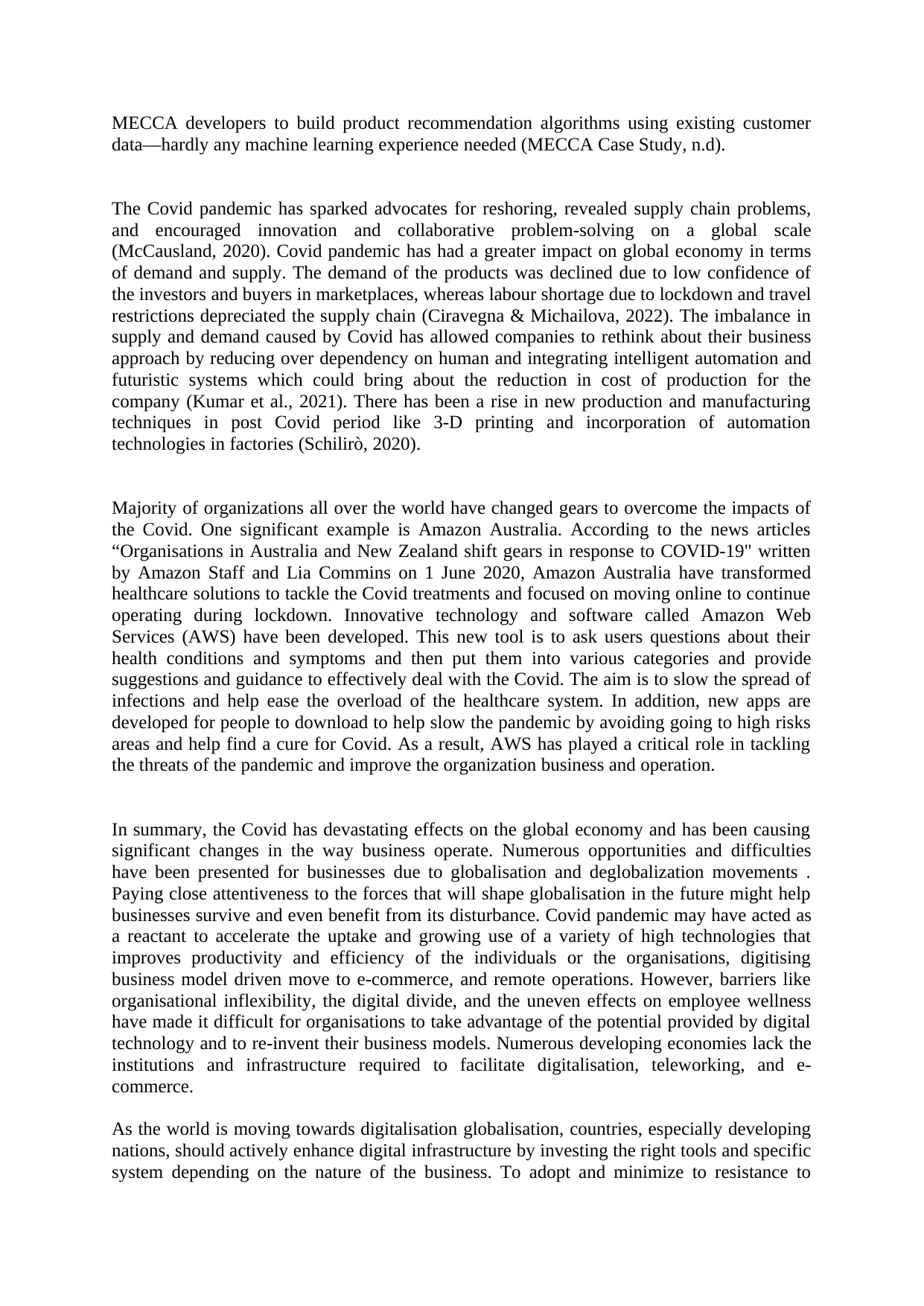
MECCA developers to build product recommendation algorithms using existing customer
data—hardly any machine learning experience needed (MECCA Case Study, n.d).
The Covid pandemic has sparked advocates for reshoring, revealed supply chain problems,
and encouraged innovation and collaborative problem-solving on a global scale
(McCausland, 2020). Covid pandemic has had a greater impact on global economy in terms
of demand and supply. The demand of the products was declined due to low confidence of
the investors and buyers in marketplaces, whereas labour shortage due to lockdown and travel
restrictions depreciated the supply chain (Ciravegna & Michailova, 2022). The imbalance in
supply and demand caused by Covid has allowed companies to rethink about their business
approach by reducing over dependency on human and integrating intelligent automation and
futuristic systems which could bring about the reduction in cost of production for the
company (Kumar et al., 2021). There has been a rise in new production and manufacturing
techniques in post Covid period like 3-D printing and incorporation of automation
technologies in factories (Schilirò, 2020).
Majority of organizations all over the world have changed gears to overcome the impacts of
the Covid. One significant example is Amazon Australia. According to the news articles
“Organisations in Australia and New Zealand shift gears in response to COVID-19" written
by Amazon Staff and Lia Commins on 1 June 2020, Amazon Australia have transformed
healthcare solutions to tackle the Covid treatments and focused on moving online to continue
operating during lockdown. Innovative technology and software called Amazon Web
Services (AWS) have been developed. This new tool is to ask users questions about their
health conditions and symptoms and then put them into various categories and provide
suggestions and guidance to effectively deal with the Covid. The aim is to slow the spread of
infections and help ease the overload of the healthcare system. In addition, new apps are
developed for people to download to help slow the pandemic by avoiding going to high risks
areas and help find a cure for Covid. As a result, AWS has played a critical role in tackling
the threats of the pandemic and improve the organization business and operation.
In summary, the Covid has devastating effects on the global economy and has been causing
significant changes in the way business operate. Numerous opportunities and difficulties
have been presented for businesses due to globalisation and deglobalization movements .
Paying close attentiveness to the forces that will shape globalisation in the future might help
businesses survive and even benefit from its disturbance. Covid pandemic may have acted as
a reactant to accelerate the uptake and growing use of a variety of high technologies that
improves productivity and efficiency of the individuals or the organisations, digitising
business model driven move to e-commerce, and remote operations. However, barriers like
organisational inflexibility, the digital divide, and the uneven effects on employee wellness
have made it difficult for organisations to take advantage of the potential provided by digital
technology and to re-invent their business models. Numerous developing economies lack the
institutions and infrastructure required to facilitate digitalisation, teleworking, and e-
commerce.
As the world is moving towards digitalisation globalisation, countries, especially developing
nations, should actively enhance digital infrastructure by investing the right tools and specific
system depending on the nature of the business. To adopt and minimize to resistance to
data—hardly any machine learning experience needed (MECCA Case Study, n.d).
The Covid pandemic has sparked advocates for reshoring, revealed supply chain problems,
and encouraged innovation and collaborative problem-solving on a global scale
(McCausland, 2020). Covid pandemic has had a greater impact on global economy in terms
of demand and supply. The demand of the products was declined due to low confidence of
the investors and buyers in marketplaces, whereas labour shortage due to lockdown and travel
restrictions depreciated the supply chain (Ciravegna & Michailova, 2022). The imbalance in
supply and demand caused by Covid has allowed companies to rethink about their business
approach by reducing over dependency on human and integrating intelligent automation and
futuristic systems which could bring about the reduction in cost of production for the
company (Kumar et al., 2021). There has been a rise in new production and manufacturing
techniques in post Covid period like 3-D printing and incorporation of automation
technologies in factories (Schilirò, 2020).
Majority of organizations all over the world have changed gears to overcome the impacts of
the Covid. One significant example is Amazon Australia. According to the news articles
“Organisations in Australia and New Zealand shift gears in response to COVID-19" written
by Amazon Staff and Lia Commins on 1 June 2020, Amazon Australia have transformed
healthcare solutions to tackle the Covid treatments and focused on moving online to continue
operating during lockdown. Innovative technology and software called Amazon Web
Services (AWS) have been developed. This new tool is to ask users questions about their
health conditions and symptoms and then put them into various categories and provide
suggestions and guidance to effectively deal with the Covid. The aim is to slow the spread of
infections and help ease the overload of the healthcare system. In addition, new apps are
developed for people to download to help slow the pandemic by avoiding going to high risks
areas and help find a cure for Covid. As a result, AWS has played a critical role in tackling
the threats of the pandemic and improve the organization business and operation.
In summary, the Covid has devastating effects on the global economy and has been causing
significant changes in the way business operate. Numerous opportunities and difficulties
have been presented for businesses due to globalisation and deglobalization movements .
Paying close attentiveness to the forces that will shape globalisation in the future might help
businesses survive and even benefit from its disturbance. Covid pandemic may have acted as
a reactant to accelerate the uptake and growing use of a variety of high technologies that
improves productivity and efficiency of the individuals or the organisations, digitising
business model driven move to e-commerce, and remote operations. However, barriers like
organisational inflexibility, the digital divide, and the uneven effects on employee wellness
have made it difficult for organisations to take advantage of the potential provided by digital
technology and to re-invent their business models. Numerous developing economies lack the
institutions and infrastructure required to facilitate digitalisation, teleworking, and e-
commerce.
As the world is moving towards digitalisation globalisation, countries, especially developing
nations, should actively enhance digital infrastructure by investing the right tools and specific
system depending on the nature of the business. To adopt and minimize to resistance to
Paraphrase This Document
Need a fresh take? Get an instant paraphrase of this document with our AI Paraphraser
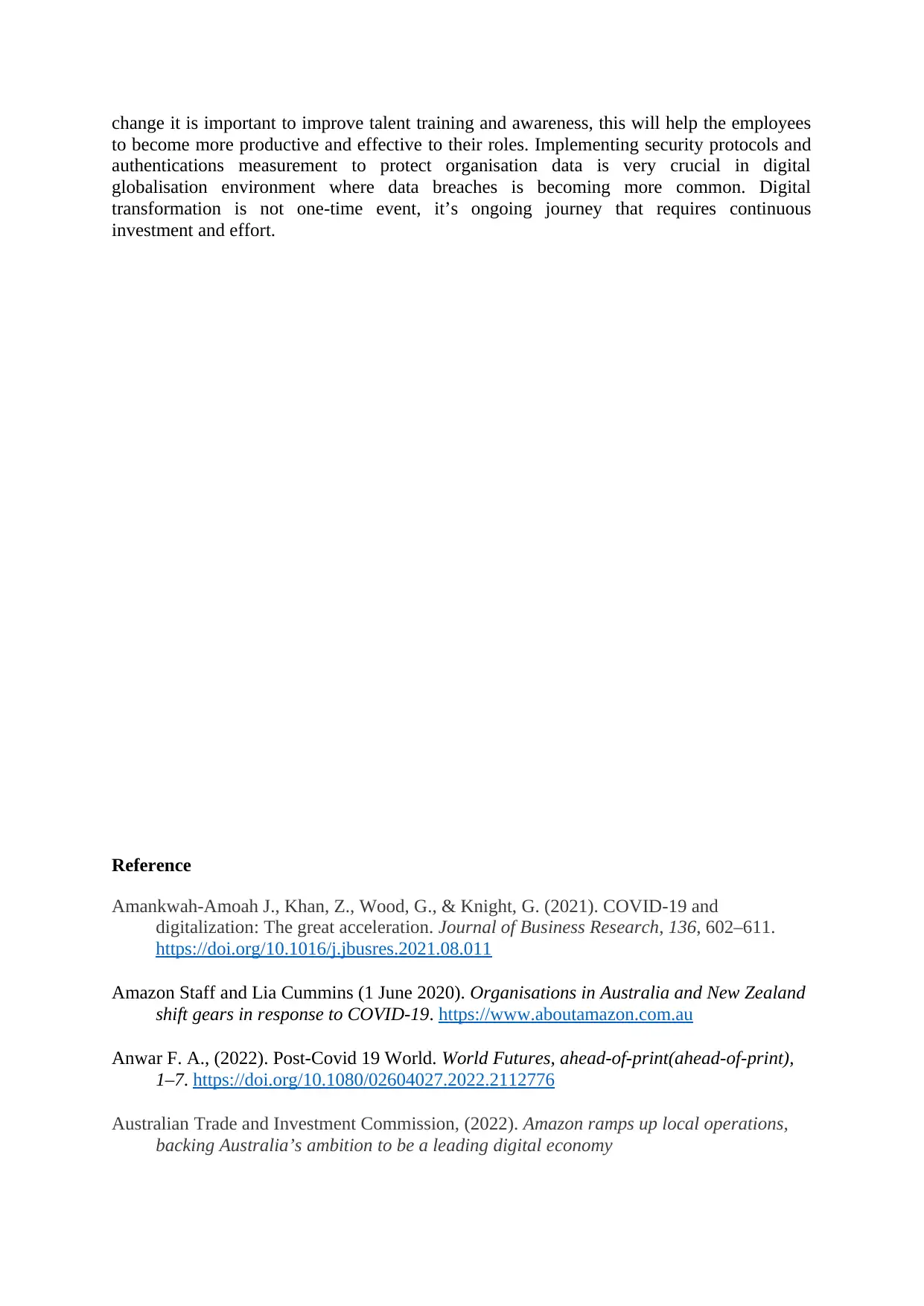
change it is important to improve talent training and awareness, this will help the employees
to become more productive and effective to their roles. Implementing security protocols and
authentications measurement to protect organisation data is very crucial in digital
globalisation environment where data breaches is becoming more common. Digital
transformation is not one-time event, it’s ongoing journey that requires continuous
investment and effort.
Reference
Amankwah-Amoah J., Khan, Z., Wood, G., & Knight, G. (2021). COVID-19 and
digitalization: The great acceleration. Journal of Business Research, 136, 602–611.
https://doi.org/10.1016/j.jbusres.2021.08.011
Amazon Staff and Lia Cummins (1 June 2020). Organisations in Australia and New Zealand
shift gears in response to COVID-19. https://www.aboutamazon.com.au
Anwar F. A., (2022). Post-Covid 19 World. World Futures, ahead-of-print(ahead-of-print),
1–7. https://doi.org/10.1080/02604027.2022.2112776
Australian Trade and Investment Commission, (2022). Amazon ramps up local operations,
backing Australia’s ambition to be a leading digital economy
to become more productive and effective to their roles. Implementing security protocols and
authentications measurement to protect organisation data is very crucial in digital
globalisation environment where data breaches is becoming more common. Digital
transformation is not one-time event, it’s ongoing journey that requires continuous
investment and effort.
Reference
Amankwah-Amoah J., Khan, Z., Wood, G., & Knight, G. (2021). COVID-19 and
digitalization: The great acceleration. Journal of Business Research, 136, 602–611.
https://doi.org/10.1016/j.jbusres.2021.08.011
Amazon Staff and Lia Cummins (1 June 2020). Organisations in Australia and New Zealand
shift gears in response to COVID-19. https://www.aboutamazon.com.au
Anwar F. A., (2022). Post-Covid 19 World. World Futures, ahead-of-print(ahead-of-print),
1–7. https://doi.org/10.1080/02604027.2022.2112776
Australian Trade and Investment Commission, (2022). Amazon ramps up local operations,
backing Australia’s ambition to be a leading digital economy
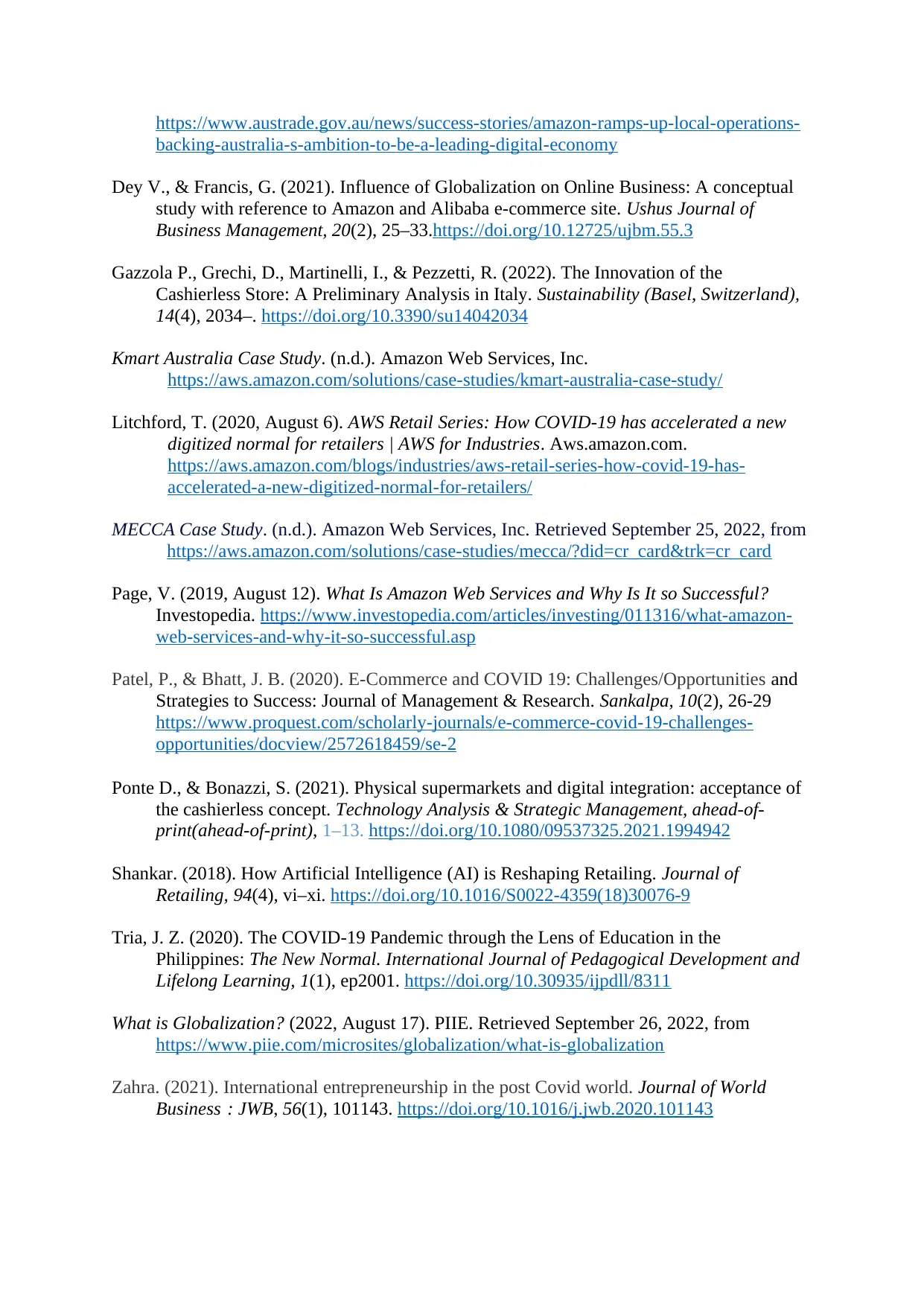
https://www.austrade.gov.au/news/success-stories/amazon-ramps-up-local-operations-
backing-australia-s-ambition-to-be-a-leading-digital-economy
Dey V., & Francis, G. (2021). Influence of Globalization on Online Business: A conceptual
study with reference to Amazon and Alibaba e-commerce site. Ushus Journal of
Business Management, 20(2), 25–33.https://doi.org/10.12725/ujbm.55.3
Gazzola P., Grechi, D., Martinelli, I., & Pezzetti, R. (2022). The Innovation of the
Cashierless Store: A Preliminary Analysis in Italy. Sustainability (Basel, Switzerland),
14(4), 2034–. https://doi.org/10.3390/su14042034
Kmart Australia Case Study. (n.d.). Amazon Web Services, Inc.
https://aws.amazon.com/solutions/case-studies/kmart-australia-case-study/
Litchford, T. (2020, August 6). AWS Retail Series: How COVID-19 has accelerated a new
digitized normal for retailers | AWS for Industries. Aws.amazon.com.
https://aws.amazon.com/blogs/industries/aws-retail-series-how-covid-19-has-
accelerated-a-new-digitized-normal-for-retailers/
MECCA Case Study. (n.d.). Amazon Web Services, Inc. Retrieved September 25, 2022, from
https://aws.amazon.com/solutions/case-studies/mecca/?did=cr_card&trk=cr_card
Page, V. (2019, August 12). What Is Amazon Web Services and Why Is It so Successful?
Investopedia. https://www.investopedia.com/articles/investing/011316/what-amazon-
web-services-and-why-it-so-successful.asp
Patel, P., & Bhatt, J. B. (2020). E-Commerce and COVID 19: Challenges/Opportunities and
Strategies to Success: Journal of Management & Research. Sankalpa, 10(2), 26-29
https://www.proquest.com/scholarly-journals/e-commerce-covid-19-challenges-
opportunities/docview/2572618459/se-2
Ponte D., & Bonazzi, S. (2021). Physical supermarkets and digital integration: acceptance of
the cashierless concept. Technology Analysis & Strategic Management, ahead-of-
print(ahead-of-print), 1–13. https://doi.org/10.1080/09537325.2021.1994942
Shankar. (2018). How Artificial Intelligence (AI) is Reshaping Retailing. Journal of
Retailing, 94(4), vi–xi. https://doi.org/10.1016/S0022-4359(18)30076-9
Tria, J. Z. (2020). The COVID-19 Pandemic through the Lens of Education in the
Philippines: The New Normal. International Journal of Pedagogical Development and
Lifelong Learning, 1(1), ep2001. https://doi.org/10.30935/ijpdll/8311
What is Globalization? (2022, August 17). PIIE. Retrieved September 26, 2022, from
https://www.piie.com/microsites/globalization/what-is-globalization
Zahra. (2021). International entrepreneurship in the post Covid world. Journal of World
Business : JWB, 56(1), 101143. https://doi.org/10.1016/j.jwb.2020.101143
backing-australia-s-ambition-to-be-a-leading-digital-economy
Dey V., & Francis, G. (2021). Influence of Globalization on Online Business: A conceptual
study with reference to Amazon and Alibaba e-commerce site. Ushus Journal of
Business Management, 20(2), 25–33.https://doi.org/10.12725/ujbm.55.3
Gazzola P., Grechi, D., Martinelli, I., & Pezzetti, R. (2022). The Innovation of the
Cashierless Store: A Preliminary Analysis in Italy. Sustainability (Basel, Switzerland),
14(4), 2034–. https://doi.org/10.3390/su14042034
Kmart Australia Case Study. (n.d.). Amazon Web Services, Inc.
https://aws.amazon.com/solutions/case-studies/kmart-australia-case-study/
Litchford, T. (2020, August 6). AWS Retail Series: How COVID-19 has accelerated a new
digitized normal for retailers | AWS for Industries. Aws.amazon.com.
https://aws.amazon.com/blogs/industries/aws-retail-series-how-covid-19-has-
accelerated-a-new-digitized-normal-for-retailers/
MECCA Case Study. (n.d.). Amazon Web Services, Inc. Retrieved September 25, 2022, from
https://aws.amazon.com/solutions/case-studies/mecca/?did=cr_card&trk=cr_card
Page, V. (2019, August 12). What Is Amazon Web Services and Why Is It so Successful?
Investopedia. https://www.investopedia.com/articles/investing/011316/what-amazon-
web-services-and-why-it-so-successful.asp
Patel, P., & Bhatt, J. B. (2020). E-Commerce and COVID 19: Challenges/Opportunities and
Strategies to Success: Journal of Management & Research. Sankalpa, 10(2), 26-29
https://www.proquest.com/scholarly-journals/e-commerce-covid-19-challenges-
opportunities/docview/2572618459/se-2
Ponte D., & Bonazzi, S. (2021). Physical supermarkets and digital integration: acceptance of
the cashierless concept. Technology Analysis & Strategic Management, ahead-of-
print(ahead-of-print), 1–13. https://doi.org/10.1080/09537325.2021.1994942
Shankar. (2018). How Artificial Intelligence (AI) is Reshaping Retailing. Journal of
Retailing, 94(4), vi–xi. https://doi.org/10.1016/S0022-4359(18)30076-9
Tria, J. Z. (2020). The COVID-19 Pandemic through the Lens of Education in the
Philippines: The New Normal. International Journal of Pedagogical Development and
Lifelong Learning, 1(1), ep2001. https://doi.org/10.30935/ijpdll/8311
What is Globalization? (2022, August 17). PIIE. Retrieved September 26, 2022, from
https://www.piie.com/microsites/globalization/what-is-globalization
Zahra. (2021). International entrepreneurship in the post Covid world. Journal of World
Business : JWB, 56(1), 101143. https://doi.org/10.1016/j.jwb.2020.101143
⊘ This is a preview!⊘
Do you want full access?
Subscribe today to unlock all pages.

Trusted by 1+ million students worldwide

1 out of 7
Related Documents
Your All-in-One AI-Powered Toolkit for Academic Success.
+13062052269
info@desklib.com
Available 24*7 on WhatsApp / Email
![[object Object]](/_next/static/media/star-bottom.7253800d.svg)
Unlock your academic potential
Copyright © 2020–2025 A2Z Services. All Rights Reserved. Developed and managed by ZUCOL.




